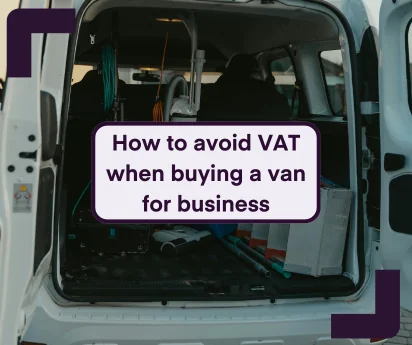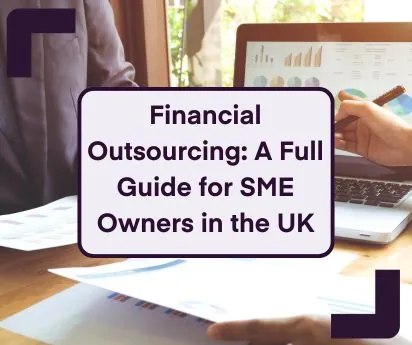
How to avoid VAT when buying a van for business
5 Jul 2020If you remember the theme tune from ‘Only Fools and Horses’, you’ll know that Del Boy was a great advocate for ‘no income tax, no VAT’. In this article, we’re not recommending Del Boy’s practices, or suggesting you pay with a briefcase full of used fivers, but explaining how to avoid VAT when buying a van.
VAT on a van for business
If you’re planning to buy a new or used van for your business, be aware that you could pay an additional 20 percent on top of the ticket price. That 20 percent is the VAT that a seller must charge you and then pay to HMRC, provided they are a registered VAT business themselves.
That will be the position for most dealerships, although the situation could vary if you were buying from another type of business or a private individual. If the other business is VAT-registered, they must also charge you VAT. That is unlikely to be the case for private individuals selling a van.
VAT of 20 percent is the basic starting point when you are calculating the likely total cost for your next VAN. However, there are a number of scenarios where you can avoid the additional cost of VAT, either by not having to pay at the time you buy or by reclaiming the VAT after the purchase.
To reclaim VAT, your business must be VAT-registered. You cannot reclaim if you are not VAT registered, and you must only use the vehicle for business. HMRC provides guidelines on reclaiming VAT on cars and commercial vehicles.
Related: Benefit In Kind: When does a van become a company car?
Buy a van from a non-registered seller
If the business or individual selling the van is not registered for VAT, they cannot charge VAT on the selling price. To charge would be illegal. So it’s essential when you approach a seller to ask if they are VAT-registered.
If they claim to be registered, ask for a VAT invoice. This must include their registration number and will allow you to reclaim any VAT.
Pay VAT on part of the purchase price
Some VAT-registered dealers operate under the VAT margin scheme. This means that they only have to charge VAT on the difference between the amount they paid to buy the vehicle and the amount they sell it for.
As an example, if a dealer buys a van for £9,000 and sells it for £10,500, they will only charge you, and pay HMRC, 20 percent VAT on the difference of £1,500. So, your VAT bill will be £300 rather than £2,100 on a ticket price of £10,500, a significant saving.
However, under the VAT margin scheme, the dealer must not provide you with a VAT invoice and you cannot try to reclaim the VAT. In some situations, this may not be a real advantage as we’ll show in a later example.
How to avoid VAT when buying a van through a limited company
If your business is a VAT-registered limited company, you can buy a new or used van in a tax efficient way. However, the vehicle must be classified as a van, not any other type of vehicle. An estate car, for example, would not be classified as a van, even if you used it for business deliveries. And, the vehicle must only be used for business purposes. Any private use will incur tax and National Insurance charges.
You will pay VAT to a VAT-registered seller and you can reclaim the VAT you paid. You can also reduce your Corporation Tax bill by writing off the whole cost of the vehicle in your capital allowance claim.
If you buy from a non-registered seller, you would not be able to reclaim the VAT, but you could make use of the Corporation Tax benefit.
Related: How to pay Corporation Tax: A guide to rates & deadlines
Related: UK business mileage allowance and mileage allowance relief
Do a deal on price
As we indicated in the section on ‘Pay VAT on part of the purchase price’, in certain situations it may not always be a benefit to buy under the VAT margin scheme. However, by negotiating a different price with the seller, both parties can benefit as this example shows. If you are taking this approach, make sure you have a calculator!
The dealer is selling a van for £16,000. Their purchase price was £13,000, so their margin was £3,000. You will pay VAT of £600 but you cannot reclaim that figure under the VAT margin scheme.
The dealer will also have to pay HMRC the VAT collected of £600 and that effectively reduces their profit to £2,400. But, if you ask the dealer to sell you the vehicle outside the VAT margin scheme and reduce the selling price, you will both gain.
If the selling price drops to £15,700 plus VAT on the selling price, you will pay £18,840.You can then reclaim the full amount of VAT - £3140 – and will have made an overall saving on the price.
The dealer also wins because they will retain £15,700 after paying HMRC the VAT. Under the VAT margin scheme, they would only have retained £15,400 after paying £600 to HMRC.
Support from Accounts and Legal
This is helps answer the question 'How to avoid VAT when buying a van?' If you would like professional advice on the financial implications of buying a van for your business, or would like confirmation that you are complying with HMRC’s VAT rules, our team of experienced tax accountants will be glad to help.
To find out more, please contact us on 0207 043 4000 or info@accountsandlegal.co.uk. You can also get a quick online accountancy quote here.
Read More: Tax Debate: Company car or car allowance?






















